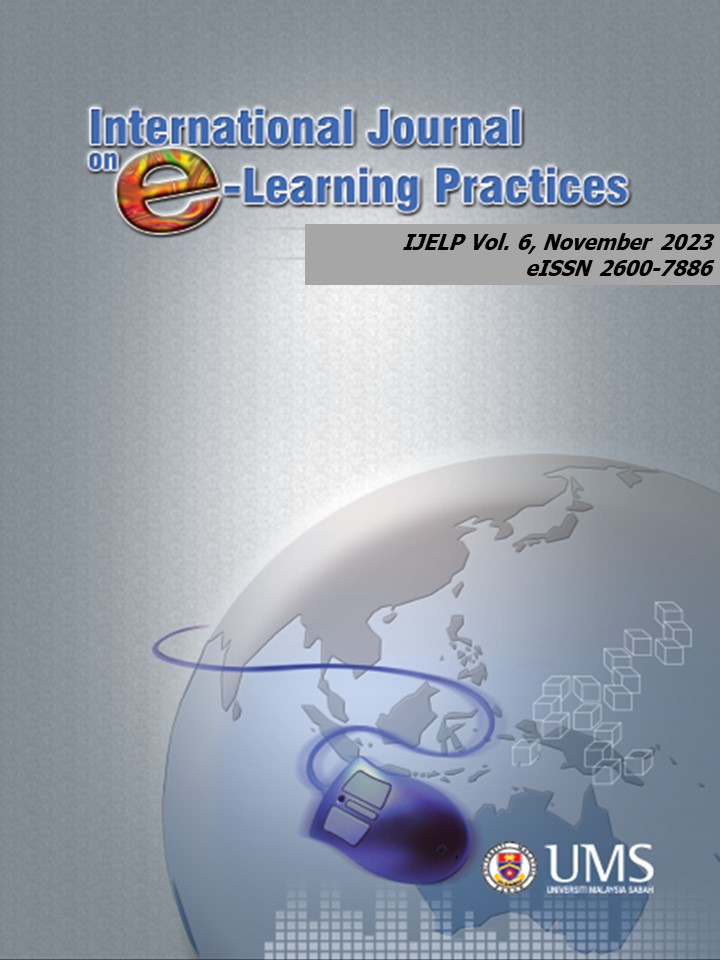The Impact of Educational Technology on Distance Learning in The Era of Post-Covid-19
DOI:
https://doi.org/10.51200/ijelp.v6i1.4301Keywords:
e-learning, distance learning, educational technology, online education during pandemic, post COVID-19Abstract
E-learning is a type of electronic educational technology that enables online or distance learning to become the norm even before the COVID-19 era. It is a depiction of convergent products, services, and activities that have emerged in the digital media space and are thought to be more efficient at delivering learning and content, resulting in time and cost savings, and having a smaller negative impact on the environment. Based on existing research, the problem area of this study is to understand how technological convergence provides opportunities to promote the convenience of distance learning and its effect on society, as well as the barriers to the idea remaining implemented post-COVID-19. This paper collects data through a semi-systematic literature review based on similar themes which are educational technology, distance learning, and education during and post COVID-19. The primary objectives of this article are to analyse and discuss the impact of educational technology, as well as to discuss the implications of distance learning, particularly after the world was compelled to embrace it during the COVID-19 lockdown. In summary, it appears that educational technology is growing more interactive, mobile, immersive, and ubiquitous in the second decade of this twenty-first century. The development of digital platforms and tools, the availability of digital content to adult professionals, and self-paced continuous learning appear to be the key components of the learning of the future. Although numerous challenges such as infrastructure and internet must be addressed, distance learning has a bright future, and e-learning is the most effective tool for achieving it. More research is needed to shed light on educational technology as a product of technological convergence, which is not only about unification and commonality but also about divergence in various aspects and opportunities.
References
Abouelnaga, H. M., Metwally, A. B., Aldhmour, K., Shoshan, H., Saleh, M., Mazouz, L. A., Abouelmagd, H., Alsmadi, S., Aljamaeen, R., Eljawad, L., & Hamad, A. L. (2019). A Survey on Educational Technology in Saudi Arabia. International Journal of Applied Engineering Research, 14, 4149–4160. http://www.ripublication.com
Abuhammad, S. (2020). Barriers to distance learning during the COVID-19 outbreak: A qualitative review from parents’ perspective. Heliyon, 6(11), e05482. https://doi.org/10.1016/j.heliyon.2020.e05482
Bergdahl, N., & Nouri, J. (2021). Covid-19 and Crisis-Prompted Distance Education in Sweden. Technology, Knowledge and Learning, 26(3), 443–459. https://doi.org/10.1007/s10758-020-09470-6
Blakeborough, D. (2014). New Media: An Introduction (Second Canadian Edition). Canadian Journal of Communication, 39(4). https://doi.org/10.22230/cjc.2014v39n4a2907
Bond, M., & Bedenlier, S. (2019). Facilitating student engagement through educational technology: Towards a conceptual framework. Journal of Interactive Media in Education, 2019(1), 1–14. https://doi.org/10.5334/jime.528
Bozkurt, A. (2020). Educational Technology Research Patterns in the Realm of the Digital Knowledge Age. Journal of Interactive Media in Education, 2020(1), 18. https://doi.org/10.5334/jime.570
Khuong, L. Q. (2022). Students’ experience on learning English essay writing with teacher’s application of online tools. International Journal on E-Learning Practices, 5, 23–30. https://jurcon.ums.edu.my/ojums/index.php/ijelp/article/view/4096
Lamb, A. J., & Weiner, J. M. (2021). Technology as infrastructure for change: district leader understandings of 1:1 educational technology initiatives and educational change. Journal of Educational Administration, 59(3), 335–351. https://doi.org/10.1108/JEA-10-2020-0220/FULL/PDF
Menon, S., & Suresh, M. (2022). Enablers of technology agility in higher education. International Journal of Information and Learning Technology, 39(2), 166–196. https://doi.org/10.1108/IJILT-07-2021-0107/FULL/PDF
ÖZÜDOĞRU, G. (2021). Problems faced in distance education during Covid-19 Pandemic. Participatory Educational Research, 8(4), 321–333. https://doi.org/10.17275/per.21.92.8.4
Park, S. (2017). Digital inequalities in rural Australia: A double jeopardy of remoteness and social exclusion. Journal of Rural Studies, 54, 399–407. https://doi.org/10.1016/j.jrurstud.2015.12.018
Quyen, T. N. Q. (2022). IMPROVE STUDENTS’ ENGLISH VOCABULARY WITH THE MEMRISE MOBILE APPLICATION. International Journal on E-Learning Practices (IJELP), 5, 12–22. https://jurcon.ums.edu.my/ojums/index.php/ijelp/article/view/4095
Schneider, S. L., & Council, M. L. (2021). Distance learning in the era of COVID-19. Archives of Dermatological Research, 313(5), 389–390. https://doi.org/10.1007/s00403-020-02088-9
Serrano-Santoyo, A., & Cabrera-Flores, M. R. (2014). Channeling Digital Convergence in Education for Societal Benefit [Commentary]. IEEE Technology and Society Magazine, 33(4), 29–31. https://doi.org/10.1109/MTS.2014.2363979
Shahriar, S. H. Bin, Arafat, S., Sultana, N., Akter, S., Khan, M. M. R., Nur, J. M. E. H., & Khan, S. I. (2021). The transformation of education during the corona pandemic: exploring the perspective of the private university students in Bangladesh. Asian Association of Open Universities Journal, 16(2), 161–176. https://doi.org/10.1108/AAOUJ-02-2021-0025/FULL/PDF
Singh, J., Steele, K., & Singh, L. (2021). Combining the Best of Online and Face-to-Face Learning: Hybrid and Blended Learning Approach for COVID-19, Post Vaccine, & Post-Pandemic World. Journal of Educational Technology Systems, 50(2), 140–171. https://doi.org/10.1177/00472395211047865
Tang, C. M., & Chaw, L. Y. (2015). Digital literacy and effective learning in a blended learning environment. Proceedings of the European Conference on E-Learning, ECEL, 14, 601–610.
Valtonen, T., López-Pernas, S., Saqr, M., Vartiainen, H., Sointu, E. T., & Tedre, M. (2022). The nature and building blocks of educational technology research. Computers in Human Behavior, 128, 107123. https://doi.org/10.1016/j.chb.2021.107123
Vukanovic, Z. (2018). The Influence of Digital Convergence/Divergence on Digital Media Business Models. Lecture Notes in Computer Science (Including Subseries Lecture Notes in Artificial Intelligence and Lecture Notes in Bioinformatics), 11112 LNCS, 152–163. https://doi.org/10.1007/978-3-319-99426-0_13






